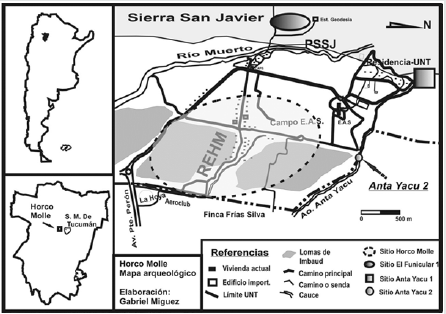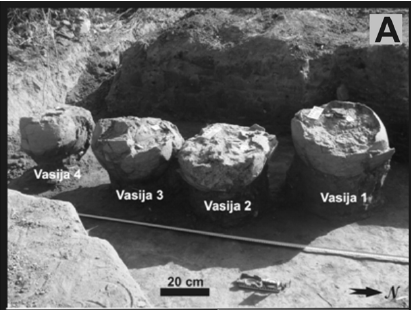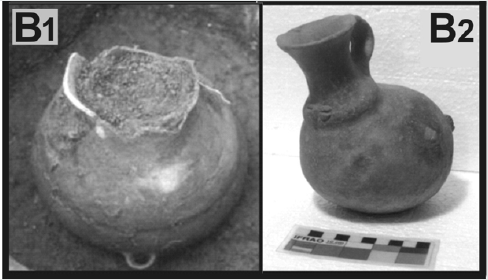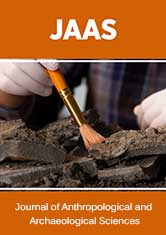
Lupine Publishers Group
Lupine Publishers
Menu
ISSN: 2690-5752
Review Article(ISSN: 2690-5752) 
New Contributions to The Chronology of The Prehispanic Occupation of The Eastern Piedemonte of The Sierra San Javier (Tucumán-Argentine): First Absolute Dates Volume 2 - Issue 4
Mario Alejandro Caria1* and Gabriel Miguez2
- 1National University of Tucuman, UNT-CONICET, Miguel Lillo, Tucumán, Argentina
- 2IAM-UNT. San Martín, Tucumán, Argentina
Received: July 01, 2020 Published: July 14, 2020
Corresponding author: Mario Alejandro Caria, National University of Tucuman, UNT-CONICET, Miguel Lillo, Tucumán, Argentina
DOI: 10.32474/JAAS.2020.02.000141
Review
Among the pending issues in the archeology of the lowlands of the province of Tucumán, the construction of chronologies based on absolute dates stands out, which allows the elaboration of more reliable pre-Hispanic occupation sequences to have a more precise temporal control of local social developments. Despite having registered dozens of archaeological sites in these jungle and forest environments, most of them do not have absolute dates.
One of the cases that manifest this situation is the archaeological record of the eastern foothills of the Sierra San Javier, located in the central portion of the Tucuman pedemontana area. After decades of research [1-4] there were still no absolute dates in this sector. One of the main reasons can be attributed to the fact that most of the studies were short-term and with little funding - carried out by students of the Career of Archeology at the National University of Tucumán in the framework of final professorship or thesis-, which were generally not included in research projects or programs with higher subsidies.
To chronologically locate the registered sites, most of the previously mentioned authors have resorted to the comparison of the registered pottery sets (classified into types or groups) with the ceramic typology elaborated by Heredia [5], with which this author built the well-known sequence of periods and phases of sociocultural development for the pre-Hispanic occupations of the southern foothills of Salta and north-central Tucumán (grouped around the concept of “Candelaria Culture”). Particular emphasis has been placed on the presence/absence of certain characteristic
features in decorated ceramics to indicate to which phase of said sequence the recovered ceramic remains would belong and, therefore, the sites studied. As a result of these typological or stylistic analogies, it has been generally proposed that the pre-Hispanic human occupations of the eastern foothills of the Sierra San Javier would be located in the first millennium AD, limiting them to this chronological range [1,2,4].
The objective of this work is to begin to build a local chronological sequence for the eastern foothills of the Sierra San Javier based on absolute dates, to begin to understand the processes of occupation that occurred in pre-colonial times. To do this, we present the first radiocarbon dating for the study area, describe the samples and their contexts of origin, and discuss the implications of their results at the local and regional level.
The Eastern Foothills of the Sierra San Javier and the Horco Molle Area
In the eastern foothills of the Sierra San Javier, the best-known area from the archaeological point of view is Horco Molle (Yerba Buena). Four archaeological sites have been recorded so far (Figure 1). Two of them are located in sectors of the lower slope of the mentioned mountain range: The Funicular 1 and Anta Yacu 1. The Horco Molle site, meanwhile, stretches for several hectares comprising the middle and distal portion of the alluvial cone of the Dead River and in summit and eastern slopes of the most-glacis. Finally, the Anta Yacu 2 site is located in the stream bed of the same name [2, 6]. In this work we focus mainly on the last two sites, since the radiocarbon dating that we present here comes from them.
Anta Yacu site 2
The registered archaeological remains consist of fragments of vessels that are scattered in a sector of the bed of the Anta Yacu stream and in the profile of its southern margin. These materials are found in a possible paleosol, located approximately 2 to 3 m deep, considering the upper limit of the mentioned profile. In an excavation carried out in the eastern sector of the site, four vessels were closely associated (without their upper parts) and aligned from south to north (Figure 2, A), whose bases reached up to 50 cm in depth, considering the surface of the bed del arroyo [6]. The internal excavation of the urns (in the laboratory) allowed determining the presence of a juvenile human individual per vessel, without associated trousseau in any of the cases. This context suggests that in this place, the secondary burial of four individuals was carried out simultaneously [7]. Absolute dating of 2190 ± 20 AP (UGA22274, bone collagen, δ13C = -8.10 / 00) was obtained from the bone material of one of these urns (Sample A). The sample selected for dating was a fragment of the lower jaw (maximum length: 34 mm) corresponding to the individual identified in ballot box No. 3, recorded at the bottom of the vessel (depth: 30-50 cm, approximately 330-350 cm from the upper edge of the southern profile of the stream).
It should be added that all the funerary vessels present a similar pottery, with certain distinctive characteristics in local archeology. Mainly the low wall thickness and the frequent presence of quartz in coarse granulometry, a scarce mineral in the local pottery for later chronologies, stand out. Although the four vessels are incomplete, in at least two of them it has been possible to infer their ovoid shapes. In addition, they were all manufactured using the ring coiling technique, have rounded bases, do not have handles or have decoration. This pottery is very similar to that recorded on the site surface.
Horco Molle Site
Possible remains of poorly preserved architectural structures, consisting of alienated metamorphic rocks or scattered semi-buried in the ground) associated with ceramic fragments, lithic remains carved in quartz and quartzite were found in some summit sectors and on the eastern slopes of the Imbaud hills. , and grinding artifacts. Along with an alignment of stones, a pre-Hispanic occupation floor was found where large ceramic fragments were recovered in a horizontal position and some quartz flakes, located in a compacted sediment level [3]. On the other hand, contexts related to domestic activities were also found in the middle and distal portion of the cone of the Dead River, with abundant ceramic fragments, carved lithic materials, grinding artifacts, bone remains, among others [4]. Close to the latter, some funerary contexts were found in urns. One of them corresponded to a secondary burial of three infants contained in a vessel that was covered with a metamorphic rock (Figure 2, B1). Inside, in addition to the human skeletal remains, a trousseau consisting of three lithic beads and a zooanthropomorphic jug (figure 2, B2), polished, with ventral symmetry, with vertical handle and applique to the nose and eye model, was recorded coffee beans [2,8]. Radiocarbon dating for this site was obtained from the bone material corresponding to this funerary context, which showed an age of 1420 ± 20 AP (UGA22275, bone collagen, δ13C = -13.130 / 00). This sample corresponds to a femur (maximum length: 77 mm) from individual n 2 of the three identified infants, who were deposited at the bottom of the vessel (depth: 40-60 cm).
In general, the ceramics at this site show greater variability and complexity than that of the previous one (Anta Yacu 2). The predominant shapes are “pucos”, pots and jugs, while the most frequent decorative features are patterned appliques (eyebrows and eyes, coffee beans), bulges or “mamelones”, incised or engraved geometric motifs, and monochrome (red) paint or bi-chrome like (red and suede or cream) [3,4].
Implications of Dating for the Local Pre-Hispanic Occupation Sequence
As we had highlighted, most of the previous studies carried out in the Horco Molle area in particular, and in the eastern foothills of the Sierra San Javier in general, locate the pre-Hispanic occupations recorded within the first millennium AD. However, the dating obtained for the Anta Yacu 2 site indicates the existence of previous occupations, which would be located at least a few centuries before the beginning of the Christian Era. The important antiquity that the dating gives to the Anta Yacu 2 site in the sequence of local pre-Hispanic occupation is in accordance with the topographic characteristics of the site and the registered pottery (homogeneous, little elaborated and without decoration), which is distinguished from other potteries corresponding to occupations registered in the Horco Molle area. This data agrees with the trend shown by other early dates obtained in nearby sites, such as the case of Acequia, in which a context of daily activities associated with a paleosol and composed of ceramic remains - rough, smooth and without decoration - and artifacts of grinding linked to a stove, was dated in 3,420 ± 40 AP [9]. On the other hand, the location of the site in the natural landscape of Anta Yacu 2 and its age, suggest the possibility that buried sites may exist in this area (under more or less powerful sediment columns) that can provide valuable information on practices and the social processes that occurred in times prior to the 2000 years AP. In this sense, the pedemontanos water courses (their beds and banks) are erected as relevant geomorphological landscape units for the detection of this type of sites. These considerations may have implications for the study of possible early human occupations (Middle and Upper Holocene) of the lowlands of Tucumán.
The dated Horco Molle site suggests that its occupation would have developed in the middle of the first millennium AD, being therefore later than Anta Yacu 2. This result shows a concordance with the relative chronology proposed in previous studies (200- 700 AD) [4]. But at the same time it shows discordance with the time range that Heredia [5] gives to vessels with features similar to those of the zooanthropomorphic jar contained inside the urn burial from which the dated sample comes, since it places them between 200- 400 AD (Chuscha phase). This fact suggests that some care should be taken with the uncritical use of ceramic typology and the chronological sequence proposed by Heredia, since most of its phases have unsubstantiated chronological ranges based on absolute dates from local archaeological contexts. Furthermore, the ceramic materials with which Heredia [5] characterizes the Candelaria II Periods (Chuscha and Ceibal Phases, 200-400 AD) and Candelaria III (Choromoro and Molleyaco 400-700 AD) and which would best represent the “Candelaria style” (since the other phases have been questioned), they are recorded in various contexts with different chronologies throughout the first millennium AD, both in the south of Salta and the Tapia-Trancas Basin and in other areas of the Argentine Northwest (Valle de Santa Marie and surrounding areas), often sharing spaces with other styles, such as Condorhuasi for the earliest cases or Santa Marie for the later ones [9-12]. These data suggest that, in a very wide area, different communities have produced, used and / or exchanged similar ceramic sets throughout the first millennium AD, within the framework of social processes that still need to be elucidated.
Finally, it should be noted that the radiocarbon dates presented and their contextualization allowed, on the one hand, building a first pre-Hispanic occupation sequence for the eastern foothills of the Sierra de San Javier, and on the other hand, to question some proposals made in previous studies on the chronological aspects of the pedemontana archeology of Tucumán.
References
- Martínez J, N Olisewski, E Ribotta, C Sotelos (1994) Primeras Investigaciones Arqueológicas en el Área de la Reserva de Flora y Fauna de Horco Molle. Actas de Resúmenes del III Congreso Nacional de Estudiantes de Arqueología 74.
- Miguez G (2010) Historia del Instituto de Arqueología y Museo en Horco Molle. En Rastros en el camino…Trayectos e identidades de una Institució Homenaje a los 80 años del IAM-UNT, editado por Aschero, C, P Arenas, C Taboada. EDUNT, San Miguel de Tucumán, pp. 329-338.
- Miguez G, M Caria (2010) La ocupación prehispánica de la Sierra San Javier y espacios aledaños (Tucumán, Argentina). En Ecología regional de una interfase natural-urbana. La Sierra de San Javier y el Gran San Miguel de Tucumán, editado por R Grau, H Bomba, M Hernández, L Paolini. EDUNT, San Miguel de Tucumán, pp. 121-137.
- Maldonado G, L Neder, J Roldán y M, Sampietro Vattuone (2011) Caracterización geoambiental y cultural del período Formativo en Selvas Occidentales Meridionales: Sitio “Horco Molle” (Dpto. Yerba Buena, Tucumán). Comechingonia 14: 115-131.
- Heredia O (1975) Investigaciones arqueológicas en el sector meridional de las Selvas Occidentales. Revista del Instituto de Antropología 5: 73-132.
- Miguez G, G Ortíz (2011) Hallazgo de un nuevo sitio y rescate de un singular contexto funerario en horco molle. Serie Monográfica y Didáctica 52: 167.
- Miguez G, M Barazutti, R Guerrero, A Bertelli (2013) Urnas en línea: Análisis contextual de una práctica funeraria registrada en la zona de Horco Molle (Tucumán, Argentina). Actas de Resúmenes del XVIII Congreso Nacional de Arqueología Argentina 586.
- Colaneri M, A Calisaya, A Gerónimo, E Milena, A González, et al. (2003) Análisis del material rescatado en Horco Molle. Serie Monográfica y Didáctica 42: 12.
- Caria M (2004) Arqueología del paisaje en la cuenca Tapia-Trancas y áreas vecinas (Tucumán-Argentina). Tesis para optar al Título de Doctor en Arqueología, Facultad de Ciencias Naturales e IML, Universidad Nacional de Tucumán, San Miguel de Tucumán,
- Berberián E, J García Azcárate, M Caillou (1977) Investigaciones arqueológicas en la región del dique el Cadillal (Tucumán-Rep. Argentina). Los primeros fechados radiocarbó Relaciones de la SAA 11: 31-53.
- Scattolin MC (2007) Santa María antes del año mil. Fechas y materiales para una historia cultural. En Sociedades Precolombinas Surandinas. Temporalidad, Interacción y Dinámica Cultural del NOA en el Ámbito de los Andes Centro-Sur, editado por V Williams, B Ventura, A Callegari, H Yacobaccio Buenos Aires, Argentina pp. 203-220.
- Caria M, J Gómez Augier (2015) Arqueología en espacios contrastados en los piedemontes oriental y occidental de Cumbres Calchaquíes (Tucumán-Argentina) durante el 1° y 2°milenio de nuestra era. En Crónicas materiales precolombinas. Arqueología de los primeros poblados del Noroeste Argentino, editado por M. A. Korstanje, M. Lazzari, M. Basile, M. F. Bugliani, V. Lema, L. Pereyra Domingorena y M. Quesada. Ediciones de la SAA, Argentina pp. 355-383.

Top Editors
-

Mark E Smith
Bio chemistry
University of Texas Medical Branch, USA -

Lawrence A Presley
Department of Criminal Justice
Liberty University, USA -

Thomas W Miller
Department of Psychiatry
University of Kentucky, USA -

Gjumrakch Aliev
Department of Medicine
Gally International Biomedical Research & Consulting LLC, USA -

Christopher Bryant
Department of Urbanisation and Agricultural
Montreal university, USA -

Robert William Frare
Oral & Maxillofacial Pathology
New York University, USA -

Rudolph Modesto Navari
Gastroenterology and Hepatology
University of Alabama, UK -

Andrew Hague
Department of Medicine
Universities of Bradford, UK -

George Gregory Buttigieg
Maltese College of Obstetrics and Gynaecology, Europe -

Chen-Hsiung Yeh
Oncology
Circulogene Theranostics, England -
.png)
Emilio Bucio-Carrillo
Radiation Chemistry
National University of Mexico, USA -
.jpg)
Casey J Grenier
Analytical Chemistry
Wentworth Institute of Technology, USA -
Hany Atalah
Minimally Invasive Surgery
Mercer University school of Medicine, USA -

Abu-Hussein Muhamad
Pediatric Dentistry
University of Athens , Greece

The annual scholar awards from Lupine Publishers honor a selected number Read More...







